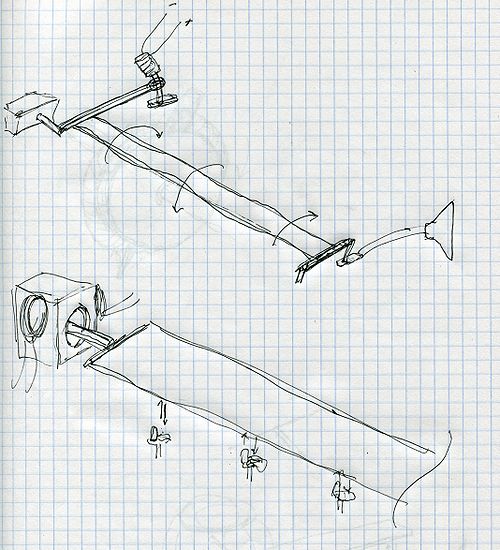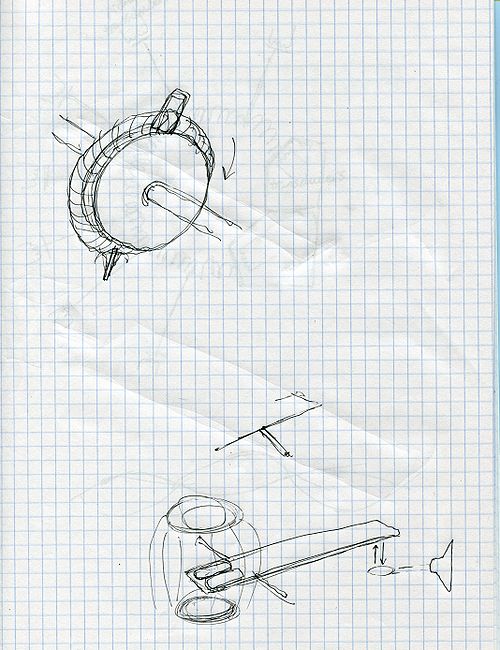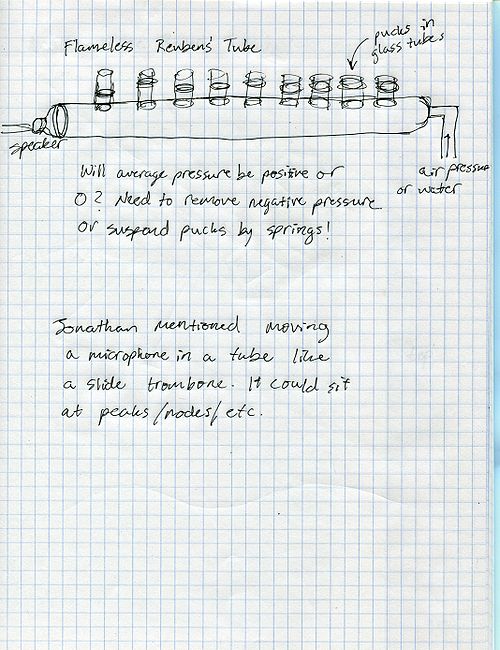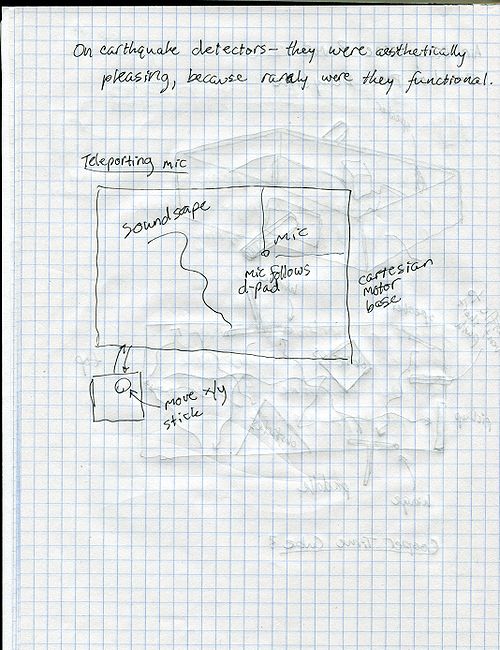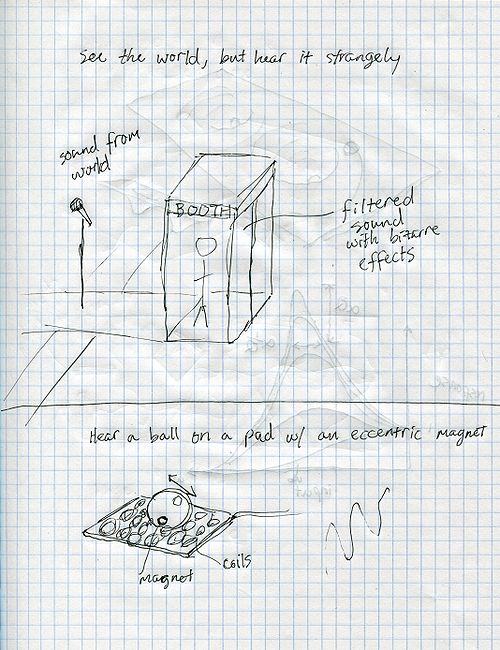Travis Geis 250B
Brainstorming for 250B.
Notebook Pages
The following pages from my notebook show some of the ideas I have about interactive sound projects.
On this page I was brainstorming how to visualize a torsional wave propagating down a medium, because it is slow enough to see. I was thinking about the reverberation effects of sending audio in one end of a thin metal strip, then picking up the vibrations at the other end. I was inspired by torsion-mode delay lines, a form of analog computer memory that used the torsional wave's slow propagation to delay a data signal by a precise constant.
In the first drawing, an electromagnet at the top left rotates an arm in a pivot (the box) to create exaggerated torsional waves in the long metal strip. At the other end, a crudely-drawn speaker picks up the movements through a piezo element and amplifies the sounds.
In the second drawing, a rotary galvanometer supplies the same torsional waves with less rotational inertia. Optical distance pickups along the edge of the metal delay strip pick up the wave at different points in space, allowing the effect of "hearing" the wave before it reaches the end of the strip. Mixing the pickup signals could make some funky sounds.
Here I was caught up on slinkies and how to make their behavior more exploitable for sound processing. I wanted a slinky wrapped around a hub of some sort, such that I could apply an impulse and observe a wave travelling without reflection until it dies. Mounting the slinky-hub appartus on an axle would allow spinning it past a fixed pick, wheel-of-fortune style, which might make some cool sounds.
In the lower drawing I was thinking about how to exaggerate an audio signal by effecting a seesaw-like lever with a magnetic field. Picking up the movements at the far end would yield some kind of muffled, low-pass audio.
Building on the ring-slinky idea, I thought about intercepting the wave partway around the circle, or even injecting signals at different points around the ring. Here some piezo elements can either listen to or play into the spring, creating a primitive and chaotic reverb.
I was thinking about how I really want to see waveforms, and how much I love Rubens' tubes. We can't use fire in a gallery space, so I just wanted to know if it would be possible to show the same thing without flames. This drawing depicts an air-filled pipe with multiple vertical clear cylinders with pistons. Playing really loud audio into one end of the pipe might create pressure differences to move the pistons.
In my writing you can see the concerns I had about negative pressures and the viscosity of the fluid. The audio might be too high-frequency to even move the pistons.
Thinking now about Piezoelectric delay lines, I wanted to control a steerable beam of sound through a maze-like enclosure. My goal was an "air delay line reverb," in which the sound waves travelled varying path lengths based on the configuration of obstacles in the center of the box and movable reflective walls on the sides.
If everything worked dramatically well, you could even play a sort of audio foosball, with players on each side controlling the path of the sound.
This rudimentary sketch depicts a soundscape of some sort over which the user can position a microphone, with the goal being a sort of auditory "teleportation." I had in mind the dramatic effects of the virtual barber shop, which convinces the listen that he/she is in a barber shop using only binaural sound. I thought about how fun it would be to "jump" somewhere with just the ears, to in effect throw my hearing across a space. Of course, the soundscape has to be fun; I do not have a specific layout in mind.
On this page I have two very different ideas.
In the top drawing I depict a glass booth, inside of which a person stands alone. The booth is sound-isolated from the outside world, and placed in some public place. The visitor can see the world like normal, but the only sounds are those picked up by the external microphone and then filtered in strange ways. There are many ways one could create a sense of disconnect and novelty with this setup:
- Delaying the sound, so the world "lags"
- "Wetting" the sound, so everything feels submarine
- Amplifying only certain frequencies, perhaps based on user input, to make sounds mysterious
My lower drawing depicts a bipolar magnetic sphere on a pad of electromegnatic pickups. Moving the ball in different orientations would cause different effects on the pickups, which would then be translated to sound somehow. I would consider this a musical instrument, or at least a sound controller, rather than an exhibit.
The sphere would not indicate the polarity or orientation of the bar magnet inside, so the effect would be something of a mystery. For example, spinning the sphere while the magnet was vertically oriented would cause no induction in the pickups, while spinning the bar magnet horizontally would create a rotational effect through several neighboring pickups.
